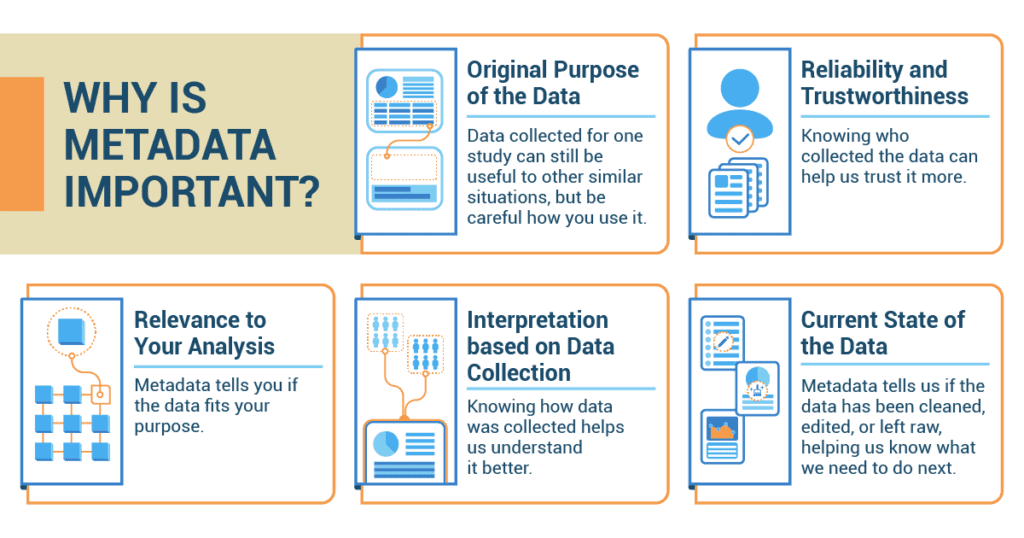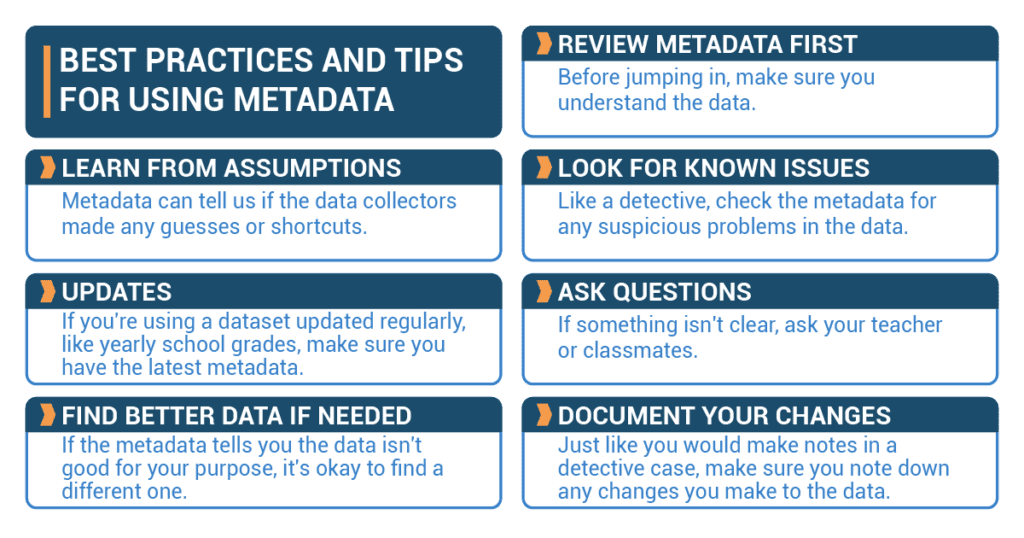I’d like you to think about a cherished photo album you have at home. Each picture tells a story, right? You remember the day, the time, the people, the smiles, the emotions. But what about those forgotten stories? The ones where the details are lost with time, like the precise day of the photo or the location. It’s frustrating, isn’t it? Now imagine what if every picture you had was automatically tagged with details like the date, the location, the people in it, the camera used, or even the weather that day. It’d be like having a time machine, wouldn’t it? Suddenly, the pictures aren’t just visual memories anymore; they are rich stories filled with context, enabling you to relive those moments more vividly.
Well, in the world of data, the extra information, the ‘who,’ ‘what,’ ‘where,’ ‘when,’ ‘how,’ and ‘why,’ is what we call Metadata.
Now, I know metadata sounds very technical, even a bit intimidating, but believe me when I say you’ve been dealing with it and using it in your everyday life without even realizing it. From Google searches and digital photos to the books you order online – metadata is everywhere, weaving context into our data-saturated lives. It is the invisible layer of information that helps us make sense of the world around us, much like those details in your photo album.
What to think about when exploring the context of your data

- The original purpose of the data: Imagine you’re studying the effects of sleeping patterns on performance. If you know the data was collected to study the adjustments on sleeping patterns, it can still be useful, but you’ll need to be careful how you use it.
- Reliability and trustworthiness of the data: Knowing the source and collection details helps assess the reliability of the data by evaluating the credibility and validity of the data collection process. It’s like knowing if your information about the latest movie comes from a professional movie critic or a random person on the internet.
- Data’s relevance to your analysis: Metadata tells you if the data fits your purpose and is meaningful to the topic. If you’re studying sleeping patterns among men in their 30s, but the data is about men in their 40s, it may not be useful.
- How to interpret the data based on data collection: Knowing how data was collected helps us understand it better. If the data came from a survey asking students about their video game habits, we know it’s based on their memory and honesty.
- The current state of the data: Metadata tells us if the data has been cleaned, edited, or left raw, helping us know what we need to do next.
How does metadata support understanding of the context of the data
Here are some questions metadata can answer when exploring the context of your data. Let’s keep using our sleeping pattern example:
- Why was the data collected? Maybe the data was collected to see what is the average time men in their 30s usually sleep at night.
- Who collected the data? Maybe it was to study brain activity and consciousness.
- What is the scope of the data?
- Location: Does it cover all men in their 30s or just some?
- Time period: Was it collected last month or five years ago?
- What were the collection methods?
- Methodology: Was it an online survey, in-person interview, or observation?
- Collection tools: Maybe an app tracked play times on a smartphone.
- Were there any data transformations? Has the data been edited or cleaned already? If your data has been collected over a long time period, metadata can help track any changes in the data collection process, measurement methods, or definitions that could affect your analysis.
- How was missing data handled? If an employee didn’t answer a question, was it left blank or filled with a guess?
Best Practices and Tips

Now, being a great detective means being careful:
- Review metadata first: Before jumping in, make sure you understand the data.
- Learn from assumptions: Metadata can tell us if the data collectors made any guesses or shortcuts.
- Look for known issues: Like a detective, check the metadata for any suspicious problems in the data.
- Updates: If you’re using a dataset updated regularly, like yearly school grades, make sure you have the latest metadata.
- Ask questions: If something isn’t clear, don’t hesitate to ask questions.
- Find better data if needed: If the metadata tells you the data isn’t good for your purpose–irrelevant, inaccurate, out-of-date, or unsuitable in some other way–it’s okay to find a different one.
- Document your changes: Just like you would make notes in a detective case, make sure you note down any changes you make to the data.
Remember, metadata is your trusty sidekick in the journey of statistics. Use it wisely, and you’ll become the Sherlock Holmes of data!
Beyond Fashion – Unveiling Trends through Metadata in Clothing Retail
Meet Sarah Mitchell, a savvy data analyst employed by a renowned clothing retail giant. Charged with deciphering consumer preferences and optimizing inventory management, Sarah embarks on a fascinating journey to explore how metadata can unlock a deeper understanding of the clothing market and reshape the way decisions are made.
Sarah is faced with a daunting challenge: understanding the dynamic world of fashion trends and customer choices. The company’s dataset is a tapestry of clothing items, each with a multitude of attributes – from color and fabric to size and style. Recognizing that each of these attributes carries invaluable contextual information, Sarah sets out to use metadata to navigate this intricate landscape.
Sarah starts her exploration by delving into the metadata associated with clothing styles. She investigates the historical context behind different fashion epochs and maps them to specific attributes. The metadata reveals fascinating insights – the resurgence of vintage styles, the cyclical nature of trends, and the influence of pop culture on clothing preferences. As Sarah dives deeper, she discovers an intriguing pattern. By examining metadata related to customer reviews and social media engagement, she unveils an untapped dimension of clothing popularity. She realizes that certain clothing items gain traction not just due to their design, but because of the stories and emotions associated with them. Metadata acts as a bridge, connecting fashion choices to the broader cultural context.
Armed with her insights, Sarah collaborates with the merchandising team to refine the clothing selection process. They embrace metadata-driven strategies, curating collections that align not only with fashion trends but also with the narratives that resonate with customers. The inclusion of context-rich metadata leads to more authentic and emotionally resonant fashion choices.
Conclusion:
Sarah’s journey illustrates the transformative role of metadata in clothing retail. By embracing metadata as a lens through which to explore the context of data, she redefines how fashion decisions are made. Beyond just colors and cuts, metadata uncovers the stories, sentiments, and societal currents that shape clothing preferences.
In this case study, Sarah’s narrative vividly demonstrates how using metadata can elevate the fashion industry. It highlights that behind the glitz and glamour lies a world of context waiting to be discovered – a world where metadata weaves the threads of insight that guide strategic decisions, resonating not just with the latest trends, but with the heartbeats of a culture.